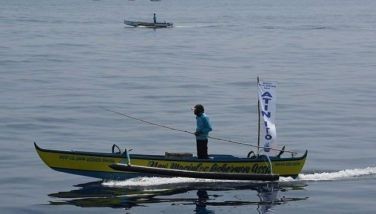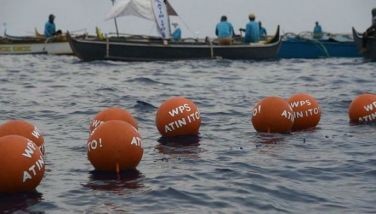Philippines, 4 others to address depleting South China Sea fish stocks

MANILA, Philippines — Five countries, including the Philippines, have launched the first Common Fisheries Resource Analysis (CFRA) to address depleting fish stocks, particularly of skipjack tuna or “gulyasan,” in the South China Sea.
The other countries are Indonesia, Malaysia, Vietnam and China.
Government-affiliated scientists from these five countries joined forces for the first landmark analysis of the region’s shared fish resources providing food and livelihoods for millions of people.
Through the CFRA, international collaboration provides science as the basis of evidence in building more sustainable management of the South China Sea’s resources.
“Each country has a piece of the puzzle and that no one country can manage fish stocks alone. The region needs to act together and that to do this, actions must be based on a scientific consensus,” said Mudjekeewis Santos, a researcher from the Department of Agriculture-National Fisheries Research and Development Institute (DA-NFRDI).
The first CFRA focuses on skipjack tuna.
“It is economically important, it can be caught by all five countries, and it is classified as highly migratory species by the UN Convention on the Law of the Sea (UNCLOS), imposing a duty of states to cooperate,” Santos said.
Prior to the launch, participants from five countries have been convening between 2018 and 2022, with more than 100 scientists and other experts contributing to the CFRA report.
According to the five-country report, there is increasing use of fishing equipment that can catch juvenile skipjack tuna throughout the South China Sea.
If left unmanaged, this could result in too many juveniles being caught before they can breed, which would result in a rapid decline in the population.
A previous study showed that the fish stocks in the region have been decreasing from 70 percent to 95 percent since the 1950s.
Science and South China Sea dispute
National Security Adviser Clarita Carlos stressed the importance of the report and how the fishing agreement can be one of the things that she would want to focus on in a non-traditional way of dealing with the dispute in the South China Sea.
She also underscored the importance of science and marine scientists all over the world as frontliners in this dispute.
“Why do I want the scientists to take the frontline here, to be the major actors in resolving the issue? Because it is the scientists who will have a different mind frame about the sea. And this is the kind of mind frame, which I feel you all have now, is that there is only one ocean, there’s only one heritage of mankind. There is only one ecology,” Carlos said.
The joint analysis of five countries shows that regional scientists can work together to develop the scientific evidence that is essential for an effective regional response.
The CFRA launch was jointly hosted by DA-NFRDI and the Centre for Humanitarian Dialogue (HD), a private diplomacy organization based in Switzerland that assists in mediation between conflicting parties to prevent or end armed conflicts.
The CFRA report is part of HD’s efforts on private diplomacy, multitrack mediation, and peacemaking efforts in more than 75 percent of armed conflicts around the world.
Chinese incursions blamed for low galunggong supply
Meanwhile, fisherfolk group Pambansang Lakas ng Kilusang Mamamalakaya ng Pilipinas (Pamalakaya) has blamed Chinese incursions in the West Philippine Sea and poor implementation of the closed fishing season policy for the dwindling supply of “galunggong” or round scad in the market.
In an interview with “The Chiefs” on Cignal TV’s One News Wednesday night, Pamalakaya national chairperson Fernando Hicap said that the country started losing its primary source of galunggong when Chinese vessels began fishing in the West Philippine Sea.
Hicap pointed out that based on Bureau of Fisheries and Aquatic Resources (BFAR) data, about 20 percent of the country’s total fisheries production was coming from the West Philippine Sea, which included up to 80 percent of the supply of galunggong.
“So, that’s what we have lost. Because now, the commercial fishing [vessels] of China can freely go fishing there while our Filipino fishermen are being harassed. There were instances that Chinese Coast Guard (personnel) were confiscating the catch of our fishermen,” Hicap said in Filipino.
Worse, the round scad caught by China from Philippine waters are now being imported by our government, said Hicap.
“This is what we called the balikbayan fish, those are from our waters, caught by China and are now being imported by our government from China,” Hicap said.
Hicap noted that the majority of the Philippines’ fish imports are from China.
“During the last quarter of 2021, the initial 2000 metric tons (of fish imports) and the additional 60,000 metric tons, majority of these were from China,” Hicap said.
‘Poor fishing ban implementation’
Also to blame is the Department of Agriculture’s supposed poor implementation of the fishing ban or the closed fishing season policy, he said.
Hicap pointed out that while their group is supportive of the policy as it promotes sustainable fishing, it is being used by the BFAR and its alleged cohort traders as an excuse for massive importation.
“The implementation of the closed season or fishing ban aims to ensure that there would be enough local supply for the whole year. But what’s happening now is that with its implementation, we just keep on importing massive volumes (of fish). That means that there is something wrong with our implementation,” he said.
“Aside from the massive importation killing our local fishing industry, imported fish also poses health risks to consumers. There have been numerous studies abroad showing that imported fish were laced with chemicals such as formalin to preserve their freshness,” Hicap added.
Philippines fisheries production bounces back
Meanwhile, the country’s fisheries production bounced back in the second quarter, owed largely to the higher output of the aquaculture, marine municipal and commercial fisheries subsectors.
Latest data from the Philippine Statistics Authority (PSA) showed the country’s April to June fisheries production went up by 5.6 percent from 1.15 million metric tons last year to 1.21 million MT this year.
The second quarter figure recovered from the 2.4 percent decline in the same period last year and the 0.2 percent decrease in the first quarter this year.
The PSA said the higher fisheries production was traced from aquaculture, commercial and marine municipal fisheries, while inland fisheries reported a drop in production.
The data showed commercial fisheries output was at 276,000 MT for the period, a 1.4 percent rise from 272,100 MT. It contributed 22.7 percent to the total fisheries production.
It also showed total unloadings in municipal landing centers rose 14.2 percent from 246,280 MT to 281,240 MT, constituting 23.2 percent of the total output.
Total harvests from aquaculture farms reached 619,460 MT, which increased by 5.8 percent from 585,480 MT last year, the PSA data showed.
The aquaculture subsector had the biggest share of 51.1 percent to the total fisheries production.
On the other hand, the PSA data showed inland municipal fisheries production slipped by 19.7 percent from 45,570 MT to 36,610 MT. It also recorded the least share to total fisheries at three percent. – Elizabeth Marcelo
- Latest
- Trending































